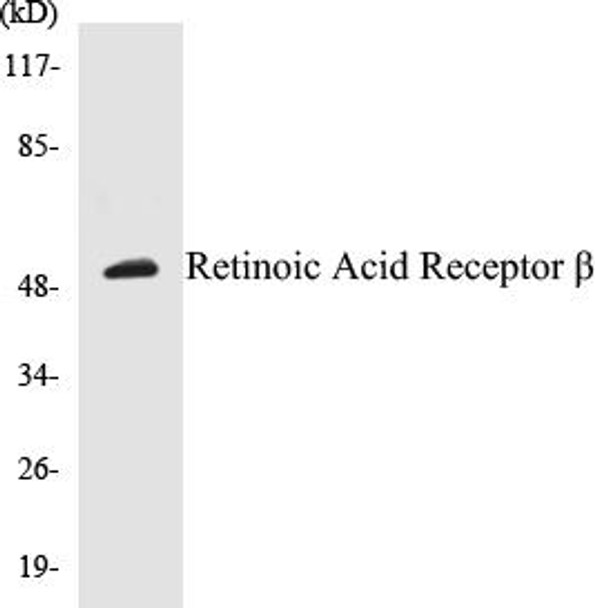Description
Retinoic Acid Receptor beta Colorimetric Cell-Based ELISA Kit
The Retinoic Acid Receptor Beta Colorimetric Cell-Based ELISA Kit is specifically designed for the accurate quantification of retinoic acid receptor beta levels in cell lysates and culture supernatants. This kit offers high sensitivity and specificity, ensuring precise and reproducible results for a variety of research applications.Retinoic acid receptor beta is a key transcription factor that plays a crucial role in regulating gene expression in response to retinoic acid signaling. Dysregulation of retinoic acid receptor beta has been linked to various diseases, including cancer, autoimmune disorders, and developmental abnormalities.
Therefore, studying the expression levels of retinoic acid receptor beta can provide valuable insights into disease mechanisms and potential therapeutic targets. The Retinoic Acid Receptor Beta Colorimetric Cell-Based ELISA Kit is a valuable tool for researchers investigating the role of retinoic acid receptor beta in health and disease. Its reliable performance and ease of use make it an essential component of any laboratory studying retinoic acid signaling pathways.
| Product Name: | Retinoic Acid Receptor beta Colorimetric Cell-Based ELISA Kit |
| Product Code: | CBCAB00355 |
| ELISA Type: | Cell-Based |
| Target: | Retinoic Acid Receptor beta |
| Reactivity: | Human, Mouse |
| Dynamic Range: | > 5000 Cells |
| Detection Method: | Colorimetric 450 nmStorage/Stability:4°C/6 Months |
| Format: | 96-Well Microplate |
The Retinoic Acid Receptor beta Colorimetric Cell-Based ELISA Kit is a convenient, lysate-free, high throughput and sensitive assay kit that can detect Retinoic Acid Receptor beta protein expression profile in cells. The kit can be used for measuring the relative amounts of Retinoic Acid Receptor beta in cultured cells as well as screening for the effects that various treatments, inhibitors (ie siRNA or chemicals), or activators have on Retinoic Acid Receptor beta.
Qualitative determination of Retinoic Acid Receptor beta concentration is achieved by an indirect ELISA format. In essence, Retinoic Acid Receptor beta is captured by Retinoic Acid Receptor beta-specific primary antibodies while the HRP-conjugated secondary antibodies bind the Fc region of the primary antibody. Through this binding, the HRP enzyme conjugated to the secondary antibody can catalyze a colorimetric reaction upon substrate addition. Due to the qualitative nature of the Cell-Based ELISA, multiple normalization methods are needed:
| 1. | A monoclonal antibody specific for human GAPDH is included to serve as an internal positive control in normalizing the target absorbance values. |
| 2. | Following the colorimetric measurement of HRP activity via substrate addition, the Crystal Violet whole-cell staining method may be used to determine cell density. After staining, the results can be analysed by normalizing the absorbance values to cell amounts, by which the plating difference can be adjusted. |
| Database Information: | Gene ID: 5915, UniProt ID: P10826, OMIM: 180220, Unigene: Hs.719896 |
| Gene Symbol: | RARB |
| Sub Type: | None |
| UniProt Protein Function: | RARB: is a receptor for retinoic acid, a potent mammalian morphogen and teratogen that has profound effects on vertebrate development. RARB is a member of the nuclear receptor superfamily. Controls cell function by directly regulating gene expression. Composed of three domains: a modulating N-terminal domain, a DNA-binding domain and a C-terminal steroid-binding domain. Four splice-variant isoforms have been described. Isoform beta-1 and beta-2 are nuclear and isoform beta-4 cytoplasmic. |
| UniProt Protein Details: | Protein type:Motility/polarity/chemotaxis; Oncoprotein; Nuclear receptor Chromosomal Location of Human Ortholog: 3p24.2 Cellular Component: nucleoplasm; cytoplasm; nucleus Molecular Function:retinoid X receptor binding; protein binding; DNA binding; zinc ion binding; protein complex binding; steroid hormone receptor activity; drug binding; retinoic acid receptor activity Biological Process: retinoic acid receptor signaling pathway; transcription initiation from RNA polymerase II promoter; regulation of myelination; glandular epithelial cell development; striatum development; positive regulation of apoptosis; embryonic eye morphogenesis; multicellular organism growth; negative regulation of chondrocyte differentiation; ventricular cardiac muscle cell differentiation; negative regulation of transcription from RNA polymerase II promoter; signal transduction; embryonic hindlimb morphogenesis; negative regulation of cell proliferation; ureteric bud development; positive regulation of cell proliferation; positive regulation of transcription from RNA polymerase II promoter; gene expression; steroid hormone mediated signaling; positive regulation of neuron differentiation; embryonic gut development; transmembrane transport; negative regulation of apoptosis Disease: Microphthalmia, Syndromic 12 |
| NCBI Summary: | This gene encodes retinoic acid receptor beta, a member of the thyroid-steroid hormone receptor superfamily of nuclear transcriptional regulators. This receptor localizes to the cytoplasm and to subnuclear compartments. It binds retinoic acid, the biologically active form of vitamin A which mediates cellular signalling in embryonic morphogenesis, cell growth and differentiation. It is thought that this protein limits growth of many cell types by regulating gene expression. The gene was first identified in a hepatocellular carcinoma where it flanks a hepatitis B virus integration site. Alternate promoter usage and differential splicing result in multiple transcript variants. [provided by RefSeq, Mar 2014] |
| UniProt Code: | P10826 |
| NCBI GenInfo Identifier: | 17380507 |
| NCBI Gene ID: | 5915 |
| NCBI Accession: | P10826.2 |
| UniProt Secondary Accession: | P10826,P12891, Q00989, Q15298, Q9UN48, |
| UniProt Related Accession: | P10826 |
| Molecular Weight: | – Da |
| NCBI Full Name: | Retinoic acid receptor beta |
| NCBI Synonym Full Names: | retinoic acid receptor, beta |
| NCBI Official Symbol: | RARB |
| NCBI Official Synonym Symbols: | HAP; RRB2; NR1B2; MCOPS12 |
| NCBI Protein Information: | retinoic acid receptor beta; RAR-beta; RAR-epsilon; HBV-activated protein; hepatitis B virus activated protein; retinoic acid receptor, beta polypeptide; nuclear receptor subfamily 1 group B member 2 |
| UniProt Protein Name: | Retinoic acid receptor beta |
| UniProt Synonym Protein Names: | HBV-activated protein; Nuclear receptor subfamily 1 group B member 2; RAR-epsilon |
| Protein Family: | Retinoic acid receptor |
| UniProt Gene Name: | RARB |
| UniProt Entry Name: | RARB_HUMAN |
| Component | Quantity |
| 96-Well Cell Culture Clear-Bottom Microplate | 2 plates |
| 10X TBS | 24 mL |
| Quenching Buffer | 24 mL |
| Blocking Buffer | 50 mL |
| 15X Wash Buffer | 50 mL |
| Primary Antibody Diluent | 12 mL |
| 100x Anti-Phospho Target Antibody | 60 µL |
| 100x Anti-Target Antibody | 60 µL |
| Anti-GAPDH Antibody | 60 µL |
| HRP-Conjugated Anti-Rabbit IgG Antibody | 12 mL |
| HRP-Conjugated Anti-Mouse IgG Antibody | 12 mL |
| SDS Solution | 12 mL |
| Stop Solution | 24 mL |
| Ready-to-Use Substrate | 12 mL |
| Crystal Violet Solution | 12 mL |
| Adhesive Plate Seals | 2 seals |
The following materials and/or equipment are NOT provided in this kit but are necessary to successfully conduct the experiment:
- Microplate reader able to measure absorbance at 450 nm and/or 595 nm for Crystal Violet Cell Staining (Optional)
- Micropipettes with capability of measuring volumes ranging from 1 µL to 1 ml
- 37% formaldehyde (Sigma Cat# F-8775) or formaldehyde from other sources
- Squirt bottle, manifold dispenser, multichannel pipette reservoir or automated microplate washer
- Graph paper or computer software capable of generating or displaying logarithmic functions
- Absorbent papers or vacuum aspirator
- Test tubes or microfuge tubes capable of storing ≥1 ml
- Poly-L-Lysine (Sigma Cat# P4832 for suspension cells)
- Orbital shaker (optional)
- Deionized or sterile water
*Note: Protocols are specific to each batch/lot. For the correct instructions please follow the protocol included in your kit.
| Step | Procedure |
| 1. | Seed 200 µL of 20,000 adherent cells in culture medium in each well of a 96-well plate. The plates included in the kit are sterile and treated for cell culture. For suspension cells and loosely attached cells, coat the plates with 100 µL of 10 µg/ml Poly-L-Lysine (not included) to each well of a 96-well plate for 30 minutes at 37°C prior to adding cells. |
| 2. | Incubate the cells for overnight at 37°C, 5% CO2. |
| 3. | Treat the cells as desired. |
| 4. | Remove the cell culture medium and rinse with 200 µL of 1x TBS, twice. |
| 5. | Fix the cells by incubating with 100 µL of Fixing Solution for 20 minutes at room temperature. The 4% formaldehyde is used for adherent cells and 8% formaldehyde is used for suspension cells and loosely attached cells. |
| 6. | Remove the Fixing Solution and wash the plate 3 times with 200 µL 1x Wash Buffer for five minutes each time with gentle shaking on the orbital shaker. The plate can be stored at 4°C for a week. |
| 7. | Add 100 µL of Quenching Buffer and incubate for 20 minutes at room temperature. |
| 8. | Wash the plate 3 times with 1x Wash Buffer for 5 minutes each time. |
| 9. | Add 200 µL of Blocking Buffer and incubate for 1 hour at room temperature. |
| 10. | Wash 3 times with 200 µL of 1x Wash Buffer for 5 minutes each time. |
| 11. | Add 50 µL of 1x primary antibodies (Anti-Retinoic Acid Receptor beta Antibody and/or Anti-GAPDH Antibody) to the corresponding wells, cover with Parafilm and incubate for 16 hours (overnight) at 4°C. If the target expression is known to be high, incubate for 2 hours at room temperature. |
| 12. | Wash 3 times with 200 µL of 1x Wash Buffer for 5 minutes each time. |
| 13. | Add 50 µL of 1x secondary antibodies (HRP-Conjugated AntiRabbit IgG Antibody or HRP-Conjugated Anti-Mouse IgG Antibody) to corresponding wells and incubate for 1.5 hours at room temperature. |
| 14. | Wash 3 times with 200 µL of 1x Wash Buffer for 5 minutes each time. |
| 15. | Add 50 µL of Ready-to-Use Substrate to each well and incubate for 30 minutes at room temperature in the dark. |
| 16. | Add 50 µL of Stop Solution to each well and read OD at 450 nm immediately using the microplate reader. |
(Additional Crystal Violet staining may be performed if desired – details of this may be found in the kit technical manual.)






